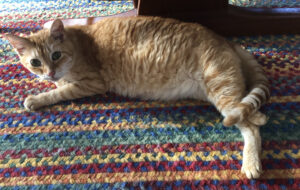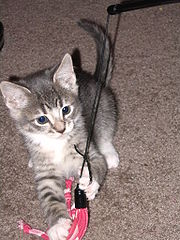
June is Adopt-A-Cat-Month, which is a purrr-fect reason for me to blog about felines. Cat Adoption has multiple applications. Sometimes the cat adopts us, as our cat Hoku did when, as a kitten, he came to our patio door every night.

Some cats are thrust upon us, as was the case when my daughter brought Koa Kat home and said we had to keep her because she was the runt of the litter. Koa is now my writing muse and has more than earned her keep. She lays on my desk to encourage writing breaks, talks to the birds outside my window, and taps her kitty wrist when it’s time to close up shop for the day — though I think she’s really reminding me to feed her.
The point is, that cats come to us in various ways and if we let them into our lives, they will repay us with love, devotion, and the occasion “present” at the back door.
Cats are popular pets, and outnumber dogs in the pet census. However, that may be because cats adapt better than dogs when left alone all day. They pretty much entertain themselves, when they aren’t sleeping 12-16 hours daily.
Academic Studies About Cats, aka, How Did You Get Funding For That?
More animal behavioral studies have been done on dogs than cats, partly because no one expects much from cats. Folklore says cats don’t attach themselves to humans, a subject that is now up for academic debate. It’s true some cats don’t like being touched, but others will actively demonstrate affection by nibbling, cuddling, and rubbing us with their heads. Cats also rub their heads on furniture, the corners of walls, and other places I haven’t noticed. The function of a head rub is to mark a place by scent. “This is my place. I belong here.”

A recent study at Cornell University demonstrates that cats may have developed their distinctive meows as a way to communicate with humans. Sounds a bit unlikely, however, researchers “interviewed” 12 cats to record 100 different vocalizations, and then played the sounds to 26 human volunteers who were requested to rate the sounds according to whether they sounded pleasant and/or appealing. But the researchers didn’t stop there. They recruited a second set of 28 volunteers and asked them to rate the cat meows on a scale of 1-7, according to how urgent the meow sounded.

Researchers concluded that cats sound urgent when they are hungry or in distress, and make a pleasanter noise if they are content and perhaps want to cuddle. [Sounds like purring to me.] Anyway, the bottom line is that cats vocalize more when they want or need human attention, and humans, through a long association with cats, think they can interpret the sound. To be fair, I don’t think humans are any better at translating dog barks than they are kitty meows.
Not to be outdone, another team of researchers, this time psychologists from the Universities of Sussex and Plymouth, studied “The Role of Cat Eye Narrowing Movements in Cat-Human Communication,” and learned that you can build rapport with your cat by using an eye-narrowing technique.

Face the cat. Narrow your eyes like you would if you were smiling. Close your eyes a couple seconds. The cat will reward you with a slow blink, and something that looks like a smile.
I’m not sure this process will lead to better quality time with your cat, but it’s an alternative activity from bouncing a lure in front of your kitten’s face.
🐱 🐱 🐱
Illustrations
Photos of Hoku and Koa Kat by Author
Cat meow graphic by Учхљёная
Kitten with Lure
Cat Smile by Yumi Kimura
“Feline Friendly? New Psychology Study Shows How to Build Rap-Paw With Your Cat.” University of Sussex. Oct 11, 2020.
Roger Segelken. “It’s the Cat’s Meow.” Cornell Cronicle. May 20, 2002.

Sandra Wagner-Wright holds the doctoral degree in history and taught women’s and global history at the University of Hawai`i. Sandra travels for her research, most recently to Salem, Massachusetts, the setting of her new Salem Stories series. She also enjoys traveling for new experiences. Recent trips include Antarctica and a river cruise on the Rhine from Amsterdam to Basel.
Sandra particularly likes writing about strong women who make a difference. She lives in Hilo, Hawai`i with her family and writes a blog relating to history, travel, and the idiosyncrasies of life.


The intro about your cat touched my ❤
Thank you, Leslie. Your comment is much appreciated. I also enjoyed the kitty photo you posted on FB.